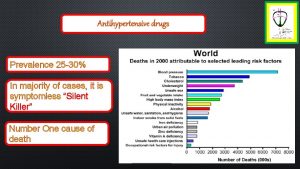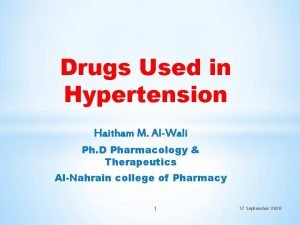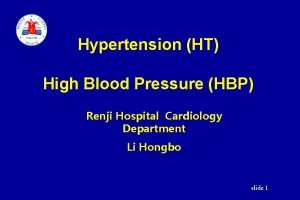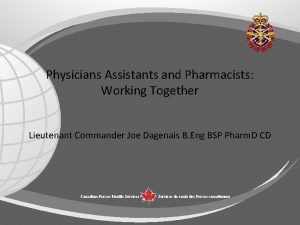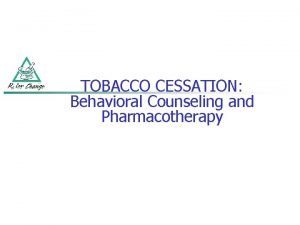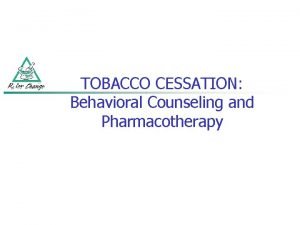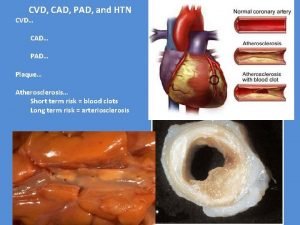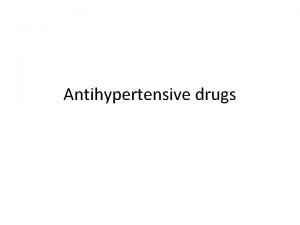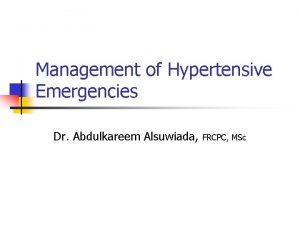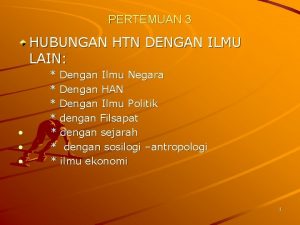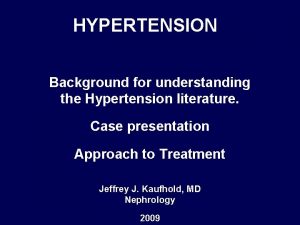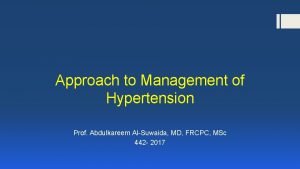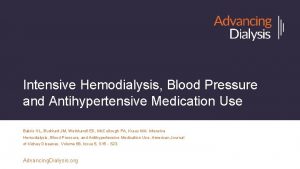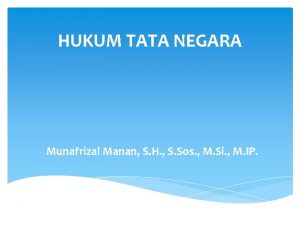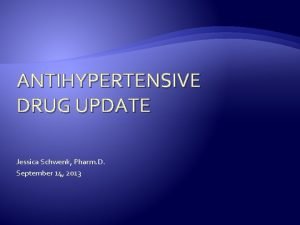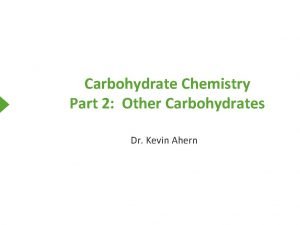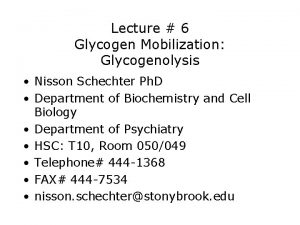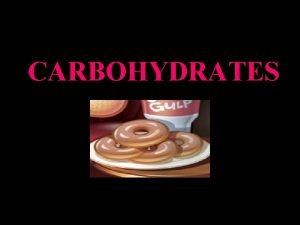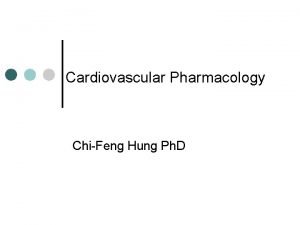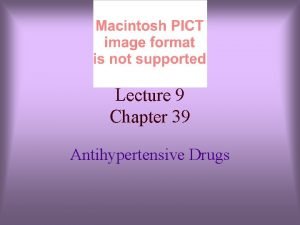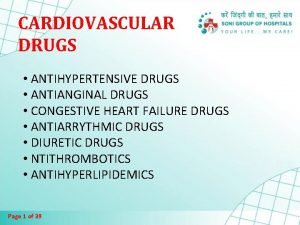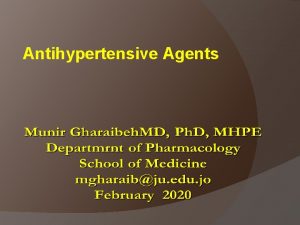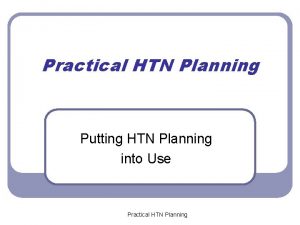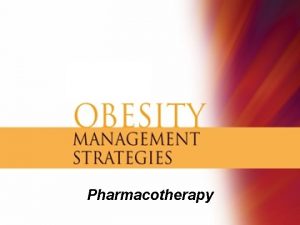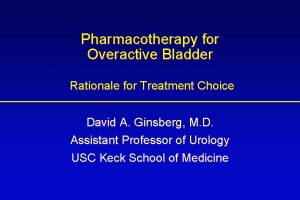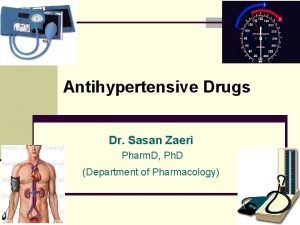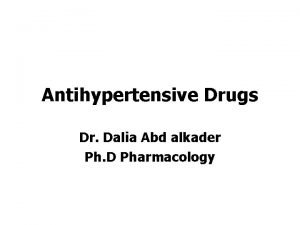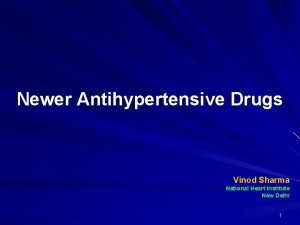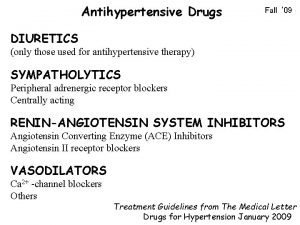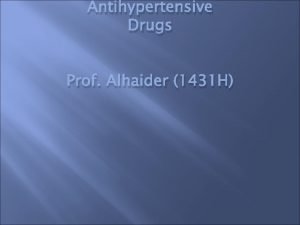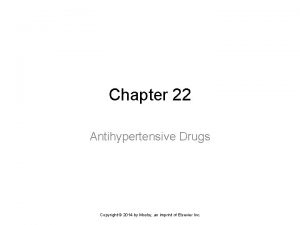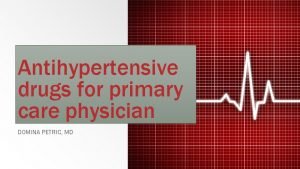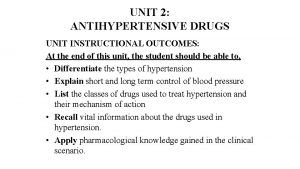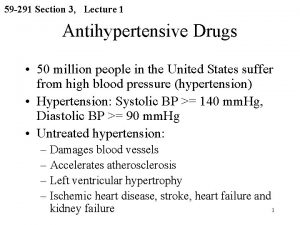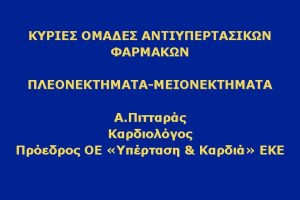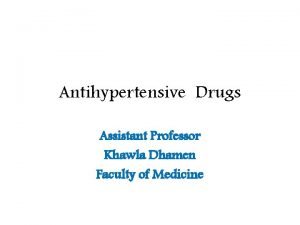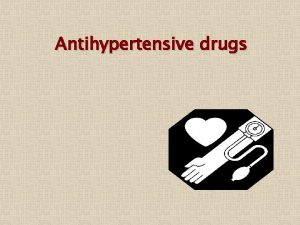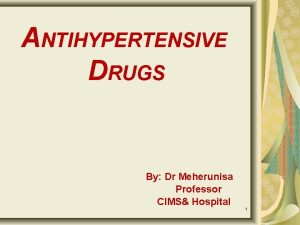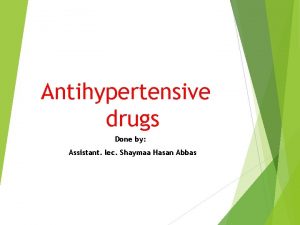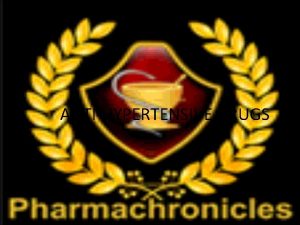Antihypertensive Drugs Pharmacotherapy of HTN Rationale for reducing
















































- Slides: 48

Antihypertensive Drugs

Pharmacotherapy of HTN Rationale for reducing arterial pressure ◦ Reduce cardiac output ◦ Reduce heart rate ◦ Reduce stroke volume Reduce system vascular Resistance ◦ Dilate systemic vasculature

Major Categories - Drugs Four major drug categories ◦ • Sympathetic nervous system suppressors: ◦ – α 1 and β 1 antagonists ◦ – α 2 agonists • Direct vasodilators: • Renin-angiotensin system targeting drugs: • Diuretics: ◦ – Calcium channel antagonists ◦ – Potassium channel agonists ◦ – ACE inhibitors ◦ – Angiotensin II receptor antagonists ◦ – Thiazides ◦ – Loop diuretics ◦ – K+ - sparing diuretics

Classification of Drugs Used in Hypertension Diuretics ◦ Osmotic ◦ Thiazide ◦ Loop ◦ K+ sparing Cardioinhibitory drugs ◦ β-blockers ◦ Ca++channel blockers Centrally Acting Sympatholytics Vasodilators ◦ ◦ ◦ α-blockers ACEi ARB Ca++channel blockers Direct acting arterial dilators ◦ Ganglionic blockers ◦ Nitrodilators ◦ K+ channel openers

Diuretics

ch an Ac ism tio n of Me Thiazides freely filtered and secreted in proximal tubule Bind to the electroneutral Na. Cl cotransporter Thiazides impair Na+ and Cl- reabsorption in the early distal tubule: “low ceiling”

Diuretics Thiazide ◦ chlorthalidone, hydrochlorothiazide (HCTZ), indapamide, metolazone Loop ◦ bumetanide, furosemide, torsemide Potassium-sparing ◦ amiloride, triamterene Aldosterone antagonists ◦ eplerenone, spironolactone 7

Osmotic Diuretics Osmotic diuretics generally consist of molecules which are small enough to pass through the ultrafiltration barrier and enter the nephron. However, the molecules that form osmotic diuretics either block the reabsorption of solutes from the nephron (especially sodium) or are not easily absorbed from the nephron themselves (mannitol). Consequently solutes remain within the filtrate and exert an osmotic effect that inhibits the reabsorption of water. ◦ This effect can also be seen if blood plasma levels of glucose become very high (e. g. in hyperglycaemic episodes experienced by individuals with diabetes mellitus). The glucose that remains unabsorbed inhibits the reabsorption of water and larger volumes of urine are typically produced, initially. 8

Thiazide Diuretics Dose in morning to avoid nocturnal diuresis Adverse effects: ◦ hypokalemia, hypomagnesemia, hypercalcemia, hyperuricemia, hyperglycemia, hyperlipidemia, sexual dysfunction ◦ lithium toxicity with concurrent administration More effective antihypertensives than loop diuretics unless Cr. Cl < 30 m. L/min Chlorthalidone 1. 5 to 2 times as potent 99

Loop Diuretics Dose in AM or afternoon to avoid nocturnal diuresis Higher doses may be needed for patients with severely decreased glomerular filtration rate or heart failure Adverse effects: ◦ hypokalemia, hypomagnesemia, hypocalcemia, hyperuricemia 10

Potassium-sparing Diuretics Dose in AM or afternoon to avoid nocturnal diuresis Generally reserved for diuretic-induced hypokalemia patients Weak diuretics, generally used in combination with thiazide diuretics to minimize hypokalemia Adverse effects: may cause hyperkalemia especially in combination with an ACE inhibitor, angiotensin-receptor blocker or potassium supplements avoid in patients with CKD or diabetes 11

Aldosterone antagonists Dose in AM or afternoon to avoid nocturnal diuresis Due to increased risk of hyperkalemia, eplerenone contraindicated in Cr. Cl < 50 m. L/min & patients with type 2 diabetes & proteinuria Adverse effects: ◦ may cause hyperkalemia especially in combination with ACE inhibitor, angiotensin-receptor blocker or potassium supplements ◦ avoid in CKD or DM patients ◦ Gynecomastia: up to 10% of patients taking spironolactone 12

Summary: Sites of Diuretic Action

Cardioinhibitory Drugs

β-Blockers Inhibit renin release ◦ weak association with antihypertensive effect Negative chronotropic & inotropic cardiac effects reduce CO ◦ β-blockers with intrinsic sympathomimetic activity (ISA) do not reduce CO lower BP decrease peripheral resistance ◦ Membrane-stabilizing action on cardiac cells at high enough doses 15

β-Blockers Adverse effects: ◦ ◦ bradycardia atrioventricular conduction abnormalities acute heart failure abrupt discontinuation may cause rebound hypertension or unstable angina, myocardial infarction, & death in patients with high coronary disease risk ◦ bronchospastic pulmonary disease exacerbation ◦ may aggravate intermittent claudication, Raynaud’s phenomenon 16

β-Receptors Distributed throughout the body ◦ concentrate differently in certain organs & tissues β 1 receptors: ◦ heart, kidney ◦ stimulation increases HR, contractility, renin release β 2 receptors: ◦ lungs, liver, pancreas, arteriolar smooth muscle ◦ stimulation causes bronchodilation & vasodilation ◦ mediate insulin secretion & glycogenolysis 17

Cardioselective β-Blockers Greater affinity for β 1 than β 2 receptors ◦ inhibit β 1 receptors at low to moderate dose ◦ higher doses block β 2 receptors Safer in patients with bronchospastic disease, peripheral arterial disease, diabetes ◦ may exacerbate bronchospastic disease when selectivity lost at high doses ◦ dose where selectivity lost varies from patient to patient Generally preferred β-blockers for HTN 18

β-Blockers Cardioselective ◦ atenolol, betaxolol, bisoprolol, metoprolol, nebivolol Nonselective ◦ nadolol, propranolol, timolol Intrinsic sympathomimetic activity ◦ acebutolol, carteolol, penbutolol, pindolol Mixed α- and β-blockers ◦ carvedilol, labetolol 19

Nonselective β-Blockers β 1 & β 2 receptors at all doses Can exacerbate bronchospastic disease Additional benefits in: Inhibit ◦ essential tremor ◦ migraine headache ◦ thyrotoxicosis 20

Intrinsic sympathomimetic activity Partial β-receptor agonists ◦ do not reduce resting HR, CO, peripheral blood flow No clear advantage except patients with bradycardia who must receive a βblocker Contraindicated post-myocardial infarction & for patients at high risk for coronary disease May not be as cardioprotective as other β-blockers Rarely used 21

Clinical Controversy suggest β-blocker based therapy may not reduce CV events as well as other agents Atenolol t½: 6 to 7 hrs yet it is often dosed once daily Meta-analyses IR forms of carvedilol & metoprolol tartrate have 6 - to 10 - & 3 - to 7 -hour half-lives respectively: always dosed at least BID Findings may only apply to atenolol may be a result of using atenolol daily instead of BID 22

Properties Of -Blockers b-1 a. Lipophil Increases Selectiv blockad ic ISA e e Atenolol Yes No No No Acebutol Dispute No No yes ol d Bisoprolo Yes No Weak No l Bucindol No No Yes Disputed ol Carvedilol No Yes No Name Celiprolol Metoprolo l Nebivolol Yes No No No Yes b-2 only No Yes No ? No Propranol No No Yes No Other ancillary properties No No No Vasodilator action Antioxidant, effects on endothelial function No No Vasodilation through nitric oxide Membrane

Mixed α- & β-blockers Carvedilol reduces mortality in patients with systolic HF treated with diuretic & ACE inhibitor Adverse effects: ◦ additional blockade produces more orthostatic hypotension 24

Calcium Channel Blockers

CCBs Calcium Channel Blockers Inhibit influx of Ca 2+ across cardiac & smooth muscle cell membranes ◦ muscle contraction requires increased free intracellular Ca 2+ concentration ◦ CCBs block high-voltage (L-type) Ca 2+ channels resulting in coronary & peripheral vasodilation dihydropyridines vs non-dihydropyridines ◦ different pharmacologically ◦ similar antihypertensive efficacy 26

CCBs Dihydropyridines: ◦ Amlodipine, felodipine, isradipine, nicardipine, nifedipine, nisoldipine, clevidipine Non-dihydropyridines: ◦ Diltiazem, verapamil Adverse effects of nondihydropyridines: ◦ Bradycardia ◦ Atrioventricular block ◦ Systolic HF 27

CCBs Dihydropyridines: ◦ baroreceptor-mediated reflex tachycardia due to potent vasodilating effects ◦ do not alter conduction through atrioventricular node not effective in supraventricular tachyarrhythmias Non-dihydropyridines: ◦ decrease HR, slow atrioventricular nodal conduction ◦ may treat supraventricular tachyarrhythmias 28

Non-dihydropyridine CCBs ER products preferred for HTN Block cardiac SA & AV nodes: reduce HR May produce heart block Not AB rated as interchangeable/equipotent due to different release mechanisms & bioavailability Additional benefits in patients with atrial tachyarrhythmia 29

Dihydropyridine CCBs Avoid short-acting dihydropyridines ◦ particularly IR nifedipine, nicardipine Dihydropyridines more potent peripheral vasodilators than nondihydropyridines may cause more reflex sympathetic discharge: tachycardia, dizziness, headaches, flushing, peripheral edema Additional benefits in Raynaud’s syndrome Effective in older patients with isolated systolic HTN 30

CCBs: Pharmacokinetics Agent Oral Absorption (%) Bioavail. Ability (%) Protein Bound (%) Elimination Half-Life (h) Verapamil >90 10 -35 83 -92 2. 8 -6. 3* Diltiazem >90 41 -67 77 -80 3. 5 -7 Nifedipine >90 45 -86 92 -98 1. 9 -5. 8 35 >95 2 -4 15 -24 >95 8 -9 20 >99 11 -16 64 -90 97 -99 30 -50 Nicardipine Isradipine Felodipine Amlodipine -100 >90

Centrally Acting Sympatholytics


Sympatholytic drugs ◦ Peripheral sympatholytic drugs such as alphaadrenoceptor and beta-adrenoceptor antagonists block the influence of norepinephrine at the effector organ (heart or blood vessel) ◦ Ganglionic blockers that block impulse transmission at the sympathetic ganglia ◦ Block sympathetic activity within the brain. These are called centrally acting sympatholytic drugs clonidine guanabenz guanfacine α-methyldopa

ACE Inhibitors 2 nd line to diuretics for most patients Block angiotensin I to angiotensin II conversion ACE (Angiotensin Converting Enzyme) distributed in many tissues primarily endothelial cells blood vessels: major site for angiotensin II production Block bradykinin degradation; stimulate synthesis of other vasodilating substances such as prostaglandin E 2 & prostacyclin Prevent or regress left ventricular hypertrophy by reducing angiotensin II myocardial stimulation 35

36 36

ACE Inhibitors Monitor serum K+ & SCr within 4 weeks of initiation or dose increase Adverse effects: ◦ cough up to 20% of patients due to increased bradykinin ◦ angioedema ◦ hyperkalemia: particularly in patients with CKD or DM ◦ neutropenia, agranulocytosis, proteinuria, glomerulonephritis, acute renal failure 37

ARBs Angiotensin II Receptor Blockers Angiotensin II generation ◦ renin-angiotensin-aldosterone pathway ◦ alternative pathway using other enzymes such as chymases Inhibit angiotensin II from all pathways ◦ directly block angiotensin II type 1 (AT 1) receptor ◦ ACE inhibitors partially block effects of angiotensin II 38

ARBs Do not block bradykinin breakdown ◦ less cough than ACE Inhibitors Adverse effects: ◦ orthostatic hypotension ◦ renal insufficiency ◦ hyperkalemia 39

40 40

AT II Receptor -Types AT 1 Receptor AT 2 Receptor Vasoconstriction Vasodilation Cell growth & Proliferation Promotes Reabsorption of Na & Water Anti-growth Produces Free radicals Induces growth factors , Endothelin and Plasminogen Activator Inhibitor 1(PAI-1) Natriuresis Produces Nitric oxide (Vasodilation)

Pathological role of AT–II

Angiotensin Receptor Blockers (ARBs) Block activation of angiotensin II AT 1 receptors Effects include: ◦ Vasodilation ◦ Reduced secretion of vasopressin ◦ Reduced production and secretion of aldosterone ◦ Reduction in blood pressure

MOA of ARB Angiotensinogen Bradykinin Renin Non ACE Pathway Angiotensin I Chymase Trypsin Cathepsin, Peptidase, Tonin Increased AG II levels Telmisartan No cough ACE Angiotensin II (AT II) AT 1 ACE Inactive peptides AT 2 • Vasoconstriction • Vasodilation • Renal sodium reabsorption • Natriuresis • Cell growth and proliferation (remodelling) • Antiproliferation

Side Effects of ARBs Usually welltolerated Dizziness Headache Hyperkalemia Infrequent ADRs First dose orthostatic hypotension Rash Diarrhea Dyspepsia Abnormal liver function Muscle cramp, back pain Insomnia, Decreased Hb Renal impairment Pharyngitis/nasal congestion

ACE I / ARBs Preferred agent in Diabetic HTN Offer Reno protection AT II ACEI / ARB Increase Intra-renal Pr & Constricts Efferent Arteriole Decreases Thickening of Glomerular basement membrane : Stimulates Renal fibrosis & Stimulates TGF beta (Hypertrophy , collagen syn. ) ; Stimulates MCP ( Inflammation) Corrects Endothelial dysfn Improvement in Endothelial fn

New Antihypertensive Drugs Vasodilator beta-blockers Renin inhibitors Endothelin receptor antagonists Dual-acting angiotensin-plus endothelinreceptor antagonist Angiotensin-targeting vaccines

Renin Inhibitors Aliskiren – Aliskiren is the first in a new class of potent, orally effective renin inhibitors. – Whereas all of the other drugs act by inhibiting certain aspects of the ultimate step in the reninangiotensin system (RAS), ie, angiotensin II, aliskiren targets the first and rate-limiting step - namely, renin.
 Antihypertensive drugs classification
Antihypertensive drugs classification Classification of antihypertensive drugs with examples
Classification of antihypertensive drugs with examples Sympatholytic classification
Sympatholytic classification Antihypertensive drugs
Antihypertensive drugs Neurotomas
Neurotomas Pharmacotherapy workup
Pharmacotherapy workup Pharmacotherapy
Pharmacotherapy Pharmacotherapy
Pharmacotherapy Htn vs goap
Htn vs goap Cad htn
Cad htn Centrally acting sympathoplegic drugs
Centrally acting sympathoplegic drugs Hypertensive emergency vs urgency
Hypertensive emergency vs urgency Hubungan htn dengan ilmu lainnya
Hubungan htn dengan ilmu lainnya Norepinephrine computation
Norepinephrine computation Htn emergency vs urgency
Htn emergency vs urgency Antihypertensive
Antihypertensive Htn statis dan dinamis
Htn statis dan dinamis Htn emergency vs urgency
Htn emergency vs urgency Reducing vs non reducing sugar
Reducing vs non reducing sugar Bial's test reagent
Bial's test reagent Reducing and non reducing end of glycogen
Reducing and non reducing end of glycogen Difference between reducing and non reducing sugars
Difference between reducing and non reducing sugars Clonidine test pheochromocytoma
Clonidine test pheochromocytoma Tack för att ni har lyssnat
Tack för att ni har lyssnat Cks
Cks Läkarutlåtande för livränta
Läkarutlåtande för livränta Inköpsprocessen steg för steg
Inköpsprocessen steg för steg Påbyggnader för flakfordon
Påbyggnader för flakfordon En lathund för arbete med kontinuitetshantering
En lathund för arbete med kontinuitetshantering Sura för anatom
Sura för anatom Egg för emanuel
Egg för emanuel Atmosfr
Atmosfr Fr formel
Fr formel Rutin för avvikelsehantering
Rutin för avvikelsehantering Presentera för publik crossboss
Presentera för publik crossboss Klassificeringsstruktur för kommunala verksamheter
Klassificeringsstruktur för kommunala verksamheter Myndigheten för delaktighet
Myndigheten för delaktighet Debatt mall
Debatt mall Var 1721 för stormaktssverige
Var 1721 för stormaktssverige Tack för att ni lyssnade
Tack för att ni lyssnade Tobinskatten för och nackdelar
Tobinskatten för och nackdelar Tack för att ni lyssnade bild
Tack för att ni lyssnade bild Vad är referatmarkeringar
Vad är referatmarkeringar Byggprocessen steg för steg
Byggprocessen steg för steg Karttecken brant
Karttecken brant Vad är vanlig celldelning
Vad är vanlig celldelning Rbk mätning
Rbk mätning Formel för lufttryck
Formel för lufttryck Elektronik för barn
Elektronik för barn
